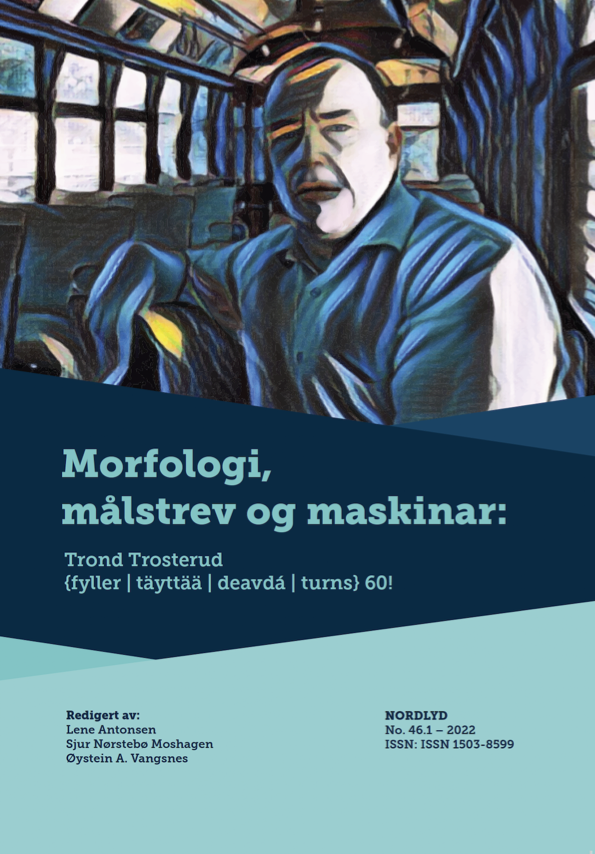Čalbmi čalmmis ja suoldnečalmmit suoidnečalmmis
Sámegielaid singulatiivvat
DOI:
https://doi.org/10.7557/12.6304Keywords:
Saami languages, singulatives, numberAbstract
North Saami čalbmi ‘eye’ (< Proto-Uralic *ćilmä) has cognates in all Uralic languages, and everywhere they refer to the visual organs of humans and animals. However, scholars have barely paid attention to the grammatical functions of čalbmi in compound-like formations such as suoldnečalbmi “dew eye”, suoidnečalbmi “grass eye”, varračalbmi “blood eye”, jiekŋačalbmi “ice eye”, vuoktačalbmi “hair eye” and muorječalbmi “berry eye”. This article examines such expressions as so-called singulatives – grammatical means for individuating a single referent from a group or mass (i.e., ‘a single drop of dew’, ‘a single blade of grass’, ‘a single drop of blood’, ‘a single crystal of ice’, ‘a single human hair’ and ‘a single berry’). The article mainly discusses morphological, syntactic and semantic features of singulatives in North Saami and other present-day Saami languages, but comparable singulatives in Khanty, Mansi and Samoyed languages as well as in Hungarian suggest that singulative expressions such as *weri-ćilmä ‘a single drop of blood’, *jäŋi-ćilmä ‘a single crystal of ice; hailstone’ and *me̮rja-ćilmä ‘a single berry’ can, in principle, be reconstructed all the way back to Proto-Uralic.
References
Aikio, Ante. 2009. The Saami loanwords in Finnish and Karelian. Nákkosgirji, Oulu universitehta, Oulu.
Aikio 2012 = Luobbal Sámmol Sámmol Ánte (Aikio, Ante). 2012. On Finnic long vowels, Samoyed vowel sequences and Proto-Uralic *x. Girjjis Per Urales ad Orientem: Iter polyphonicum multilingue. Festskrift tillägnad Juha Janhunen på hans sextioårsdag den 12 februari 2012, doaimmahan Tiina Hyytiäinen, Lotta Jalava, Janne Saarikivi ja Erika Sandman, s. 227–250. Société Finno-Ougrienne, Helsinki.
Aikio, Ante (Luobbal Sámmol Sámmol Ánte) ja Jussi Ylikoski. 2022. North Saami. Girjjis The Oxford guide to the Uralic languages, doaimmahan Marianne Bakró-Nagy, Johanna Laakso ja Elena Skribnik, s. 147–177. Oxford University Press, Oxford. https://doi.org/10.1093/oso/9780198767664.003.0010.
Bergsland, Knut ja Lajla Mattsson Magga. 1993. Åarjelsaemien daaroen baakoegærja. Sydsamisk norsk ordbok. Idut.
Bykonja, Valentina, Nadežda Kuznecova ja Natalʹja Maksimova. 2005. Selʹkupsko-russkij dialektnyj slovarʹ. Izdatelʹstvo Tomskogo gosudarstvennogo pedagogičeskogo universiteta, Tomsk.
Dali, Myriam ja Eric Mathieu. 2021. Singulative systems. Girjjis The Oxford handbook of grammatical number, doaimmahan Patricia Cabredo Hofherr ja Jenny Doetjes, s. 275–290. Oxford University Press, Oxford. https://doi.org/10.1093/oxfordhb/9780198795858.013.13.
Däbritz, Chris Lasse. 2021. Typology of number systems in languages of Western and Central Siberia. Finnisch-Ugrische Forschungen 66: 85–138. https://doi.org/10.33339/fuf.97288.
Fiellström, Petrus. 1738. Dictionarium Sueco-Lapponicum. Stockholm.
Grimm, Scott. 2018. Grammatical number and the scale of individuation. Language 94(3): 527–574. https://doi.org/10.1353/lan.2018.0035.
Haspelmath, Martin. 2019. A discussion with Edith Moravcsik about singulative markers and individualizers. Diversity Linguistics Comment. Posted on 2019-06-26 by Martin Haspelmath. https://dlc.hypotheses.org/1808.
Haspelmath, Martin ja Andres Karjus. 2017. Explaining asymmetries in number marking: Singulatives, pluratives, and usage frequency. Linguistics 55(6): 1213–1235. https://doi.org/10.1515/ling-2017-0026.
Helander, Nils Øivind. 2016. Ohppojuvvon ja sohppojuvvon giella. Gielladiđolašvuohta, čálamáhttu ja guovttegielatvuohta. Sámi allaskuvla, Guovdageaidnu.
Helimski, Eugene. 2016. S-singulatives in Ket. Journal of Language Relationship 14(3): 157–163. https://doi.org/10.31826/jlr-2017-143-404.
Itkonen, T. I. 1958. Koltan- ja kuolanlapin sanakirja. Suomalais-Ugrilainen Seura, Helsinki.
Leem, Knud. 1768. Lexicon Lapponicum bipartitum. Pars prima. Lapponico - Danico - Latina. Nidaros.
Michaelis, Susanne Maria. 2013. Antidual of paired body-part terms. Duojis The atlas of pidgin and creole language structures, doaimmahan Susanne Maria Michaelis, Philippe Maurer, Martin Haspelmath ja Magnus Huber. Max Planck Institute for Evolutionary Anthropology, Leipzig. https://apics-online.info/parameters/27.chapter.html.
Nielsen, Konrad. 1926. Lærebok i lappisk. I. Grammatikk. A.W. Brøgger, Oslo.
Nielsen, Konrad. 1932. Lappisk ordbok. Grunnet på dialektene i Polmak, Karasjok og Kautokeino. Vol. 1. A–F. Aschehoug, Oslo.
Sammallahti, Pekka. 2021. Sámi-suoma sátnegirji. Pohjoissaame – suomi -sanakirja. Davvi Girji, Kárášjohka.
SIKOR = SIKOR. UiT Norgga árktalaš universitehta ja Norgga Sámedikki sámi teakstačoakkáldat. Veršuvdna 01.10.2021. http://gtweb.uit.no/korp/.
Storch, Anne. 2014. A grammar of Luwo. An anthropological approach. Benjamins, Amsterdam. https://doi.org/10.1075/clu.12.
Ylikoski, Jussi. 2014. Davvisámegiela ‑ráigge – substantiiva, advearba, postposišuvdna vai kásus? Sámi dieđalaš áigečála 2/2014: 47–70.
Ylikoski, Jussi. 2015. From compounds to case marking: Prolatives in South Saami and Lule Saami. Finnisch-Ugrische Mitteilungen 39: 101–155.
Ylikoski, Jussi. 2021. Ice eyes, blood eyes: Remarks on the Uralic singulative marker *ćilmä ‘eye’. Språkets funktion 17, 26.–27.5.2021, Åbo. https://www.academia.edu/49054434/Ice_eyes_blood_eyes_Remarks_on_the_Uralic_singulative_marker_ćilmä_eye.
Zeuss, J. C. 1853. Grammatica Celtica. Weidmann, Lipsia.
Downloads
Published
Issue
Section
License
Copyright (c) 2022 Jussi Ylikoski

This work is licensed under a Creative Commons Attribution-NonCommercial 4.0 International License.





